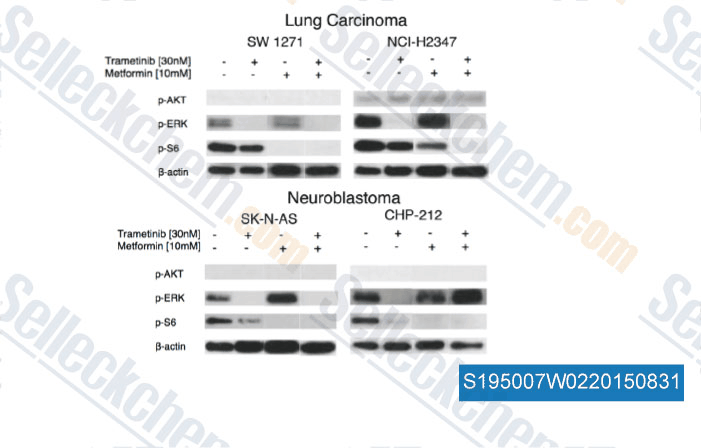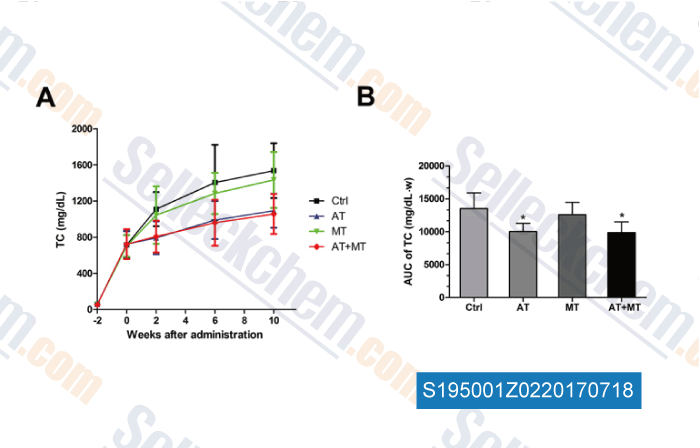|
Toll Free: (877) 796-6397 -- USA and Canada only -- |
Fax: +1-832-582-8590 Orders: +1-832-582-8158 |
Tech Support: +1-832-582-8158 Ext:3 Please provide your Order Number in the email. |
Technical Data
| Formula | C4H11N5.HCl |
||||||
| Molecular Weight | 165.62 | CAS No. | 1115-70-4 | ||||
| Solubility (25°C)* | In vitro | Water | 33 mg/mL (199.25 mM) | ||||
| DMSO | Insoluble | ||||||
| Ethanol | Insoluble | ||||||
| In vivo (Add solvents to the product individually and in order) |
|
||||||
|
* <1 mg/ml means slightly soluble or insoluble. * Please note that Selleck tests the solubility of all compounds in-house, and the actual solubility may differ slightly from published values. This is normal and is due to slight batch-to-batch variations. * Room temperature shipping (Stability testing shows this product can be shipped without any cooling measures.) |
|||||||
Preparing Stock Solutions
Biological Activity
| Description | Metformin HCl (1,1-Dimethylbiguanide HCl) decreases hyperglycemia in hepatocytes primarily by suppressing glucose production by the liver (hepatic gluconeogenesis). Metformin promotes mitophagy in mononuclear cells. Metformin induces apoptosis of lung cancer cells through activating JNK/p38 MAPK pathway and GADD153. | |
|---|---|---|
| Targets |
|
|
| In vitro | Metformin (500 μM) activates AMPK in hepatocytes, as a result, acetyl-CoA carboxylase (ACC) activity is reduced, fatty acid oxidation is induced, and expression of lipogenic enzymes is suppressed. Metformin (2 mM) activates muscle AMPK and promotes glucose uptake. Metformin (500 μM) or AICAR strongly suppresses SREBP-1 mRNA expression in rat hepatocytes. Metformin ameliorates hyperglycemia without stimulating insulin secretion, promoting weight gain, or causing hypoglycemia. Metformin has beneficial effects on circulating lipids linked to increased cardiovascular risk. Metformin decreases hepatic glucose production and increases skeletal myocyte glucose uptake. [1] Metformin requires LKB1 in the liver to lower blood glucose levels. [2] Metformin (2 mM) leads to a significant increase in the activity of both α1- and α2-containing complexes in muscle cells. Metformin (2 mM) also increases threonine 172 phosphorylation in muscle cells. [3] |
|
| In vivo | Metformin (100 mg/ml, po) treatment produces significant decreases in hepatic expression of mRNAs for SREBP-1, FAS, and S14 in SD rats that are consistent with effects documented in cells. Metformin also decreases hepatic lipids in obese mice. [1] Metformin (250 mg/kg, i.p.) increases AMPK phosphorylation in livers of wild-type mice. Metformin (250 mg/kg, i.p.) treatment reduces blood glucose by more than 50% in the wild-type mice on a high-fat diet. Metformin (250 mg/kg, i.p.) treatment also loweres blood glucose in the ob/ob mice by 40%. [2] |
Protocol (from reference)
| Cell Assay: |
|
|---|---|
| Animal Study: |
|
References
Customer Product Validation

-
Data from [Data independently produced by , , Oncotarget, 2015, 6(2): 969-78 ]

-
Data from [Data independently produced by , , Sci Rep, 2017, 7(1):2169]
Selleck's Metformin HCl has been cited by 109 publications
| TBC1D23 mediates Golgi-specific LKB1 signaling [ Nat Commun, 2024, 15(1):1785] | PubMed: 38413626 |
| PRMT5 mediated FUBP1 methylation accelerates prostate cancer progression [ J Clin Invest, 2024, e175023] | PubMed: 39146021 |
| A personalized medicine approach identifies enasidenib as an efficient treatment for IDH2 mutant chondrosarcoma [ EBioMedicine, 2024, 102:105090] | PubMed: 38547578 |
| LKB1 dictates sensitivity to immunotherapy through Skp2-mediated ubiquitination of PD-L1 protein in non-small cell lung cancer [ J Immunother Cancer, 2024, 12(12)e009444] | PubMed: 39694700 |
| The combination therapy using tyrosine kinase receptors inhibitors and repurposed drugs to target patient-derived glioblastoma stem cells [ Biomed Pharmacother, 2024, 176:116892] | PubMed: 38876048 |
| Novel Approach for Cardioprotection: In Situ Targeting of Metformin via Conductive Hydrogel System [ Polymers (Basel), 2024, 16(15)2226] | PubMed: 39125251 |
| Metformin Mitigates Sepsis-Induced Acute Lung Injury and Inflammation in Young Mice by Suppressing the S100A8/A9-NLRP3-IL-1β Signaling Pathway [ J Inflamm Res, 2024, 17:3785-3799] | PubMed: 38895139 |
| Metformin radiosensitizes OSCC in 2D and 3D models: possible involvement of CAF-1 [ Pathologica, 2024, 116(6):404-416] | PubMed: 39748725 |
| Metformin and buparlisib synergistically induce apoptosis of non-small lung cancer (NSCLC) cells via Akt/FoxO3a/Puma axis [ Toxicol In Vitro, 2024, 97:105801] | PubMed: 38479708 |
| Immuno-oncological effects of standard anticancer agents and commonly used concomitant drugs: an in vitro assessment [ BMC Pharmacol Toxicol, 2024, 25(1):25] | PubMed: 38444002 |
RETURN POLICY
Selleck Chemical’s Unconditional Return Policy ensures a smooth online shopping experience for our customers. If you are in any way unsatisfied with your purchase, you may return any item(s) within 7 days of receiving it. In the event of product quality issues, either protocol related or product related problems, you may return any item(s) within 365 days from the original purchase date. Please follow the instructions below when returning products.
SHIPPING AND STORAGE
Selleck products are transported at room temperature. If you receive the product at room temperature, please rest assured, the Selleck Quality Inspection Department has conducted experiments to verify that the normal temperature placement of one month will not affect the biological activity of powder products. After collecting, please store the product according to the requirements described in the datasheet. Most Selleck products are stable under the recommended conditions.
NOT FOR HUMAN, VETERINARY DIAGNOSTIC OR THERAPEUTIC USE.
